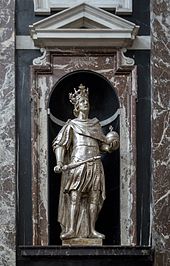Chapel of Saint Casimir
It was built and decorated in the Baroque style by Italian sculptors and architects commissioned by Sigismund III Vasa, King of Poland and Grand Duke of Lithuania.
King Sigismund III Vasa financed the construction and hired Italian architect Costante Tencalla for the chapel's plan.
[1] Three-Handed St. Casimir is an anonymous painting of Saint Casmir which hangs under his silver sarcophagus in the chapel.
Povilas Rėklaitis cited an example of Trojeručica, an icon of the Eastern Orthodox Church, as a possible inspiration.
[6] The overall composition is very similar to the woodcut published by papal legate Zacharias Ferreri in Casimir's first hagiography in 1521.
[7] The painting was touched up in 1594 as evidenced by an inscription in a Renaissance cartouche at the bottom which cites a line from Psalm 92: The righteous shall flourish like the palm tree: he shall grow like a cedar in Lebanon.
[6][8] Likely at this time, the original pendant which is worn by Casimir and which depicted Madonna with child was replaced by the Order of the Golden Fleece.
Saint Casimir did not receive the order and it was likely added to appease King Sigismund III Vasa.
Bishop Benedykt Woyna [pl], who wrote to Rome of a wonderful smell after the lid was lifted, has his hands raised to heaven in praise of the Lord.
The chapel originally had eight pure silver sculptures that measured about 1 m (3 ft 3 in) in height and that were melted during the Deluge (1655–1660), but they stood in the main altar.
[12] The first claims that the sculptures depict Polish kings were recorded in a 1828 report of canonical visitation and in a 1835 book on the history of Vilnius by Michał Baliński [pt].
[15] This theory of the Jagiellonian kings gained popularity and in 1878 the names were written in gilded letters on the postaments: Władysław II Jagiełło (Jogaila) (reigned 1386–1434), Władysław of Varna (1434–1444), Casimir IV Jagiellon (1447–1492), Saint Casimir, John I Albert (1492–1501), Alexander Jagiellon (1501–1506), Sigismund I the Old (1507–1548), and Sigismund II Augustus (1548–1572).
[19] Mindaugas Paknys noted that two sculptures wear imperial crowns (other researchers considered them grand ducal caps as they are visually very similar)[20] and suggested that they depict Camimir's grandfather Albert II of Germany, elected but not crowned King of the Romans, and Frederick III, Holy Roman Emperor, who raised orphaned Casimir's mother.

